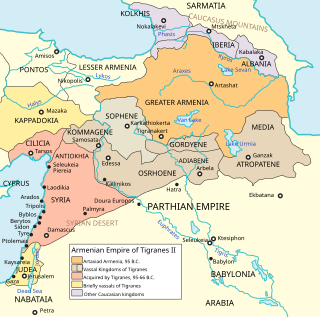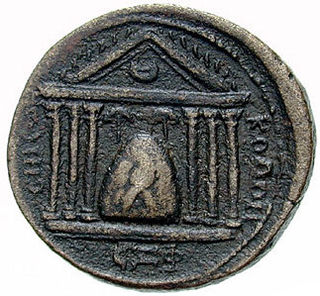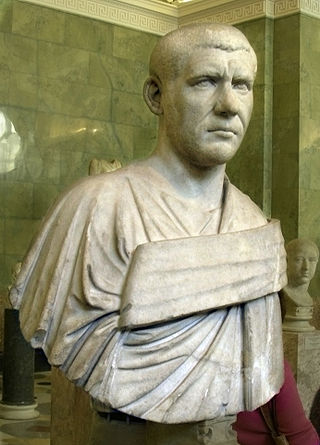
Julius Marinus was the father of Roman Emperor Philip the Arab and Philip's brother Gaius Julius Priscus.

Julius Marinus was the father of Roman Emperor Philip the Arab and Philip's brother Gaius Julius Priscus.
He was deified by his son. Scholar Pat Southern writes that this deification was unusual because Marinus was not an emperor, but it gave Philip's reign more legitimacy. [1]
He was a Roman citizen from what is today Shahba, about 55 miles (89 km) southeast of Damascus; in the Trachonitis district and then in the Roman province of Arabia Petraea.
In life Marinus was possibly of some importance. [2] By descent from Marinus, Philip held Roman citizenship. [3] [4] [5] [6]
The 240s decade ran from January 1, 240, to December 31, 249.

Gaius Messius Quintus Trajanus Decius, known as Trajan Decius or simply Decius, was Roman emperor from 249 to 251.
Elagabalus, Aelagabalus, Heliogabalus, or simply Elagabal was an Arab-Roman sun god, initially venerated in Emesa, Syria. Although there were many variations of the name, the god was consistently referred to as Elagabalus in Roman coins and inscriptions from AD 218 on, during the reign of emperor Elagabalus.

Gordian III was Roman emperor from 238 to 244. At the age of 13, he became the youngest sole emperor of the united Roman Empire. Gordian was the son of Antonia Gordiana and Junius Balbus, who died before 238. Antonia Gordiana was the daughter of Emperor Gordian I and sister of Emperor Gordian II. Very little is known of his early life before his acclamation.

Philip I, commonly known as Philip the Arab, was the Emperor of the Roman Empire from 244 to 249. After the death of Gordian III in February 244, Philip, who had been Praetorian prefect, rose to power. He quickly negotiated peace with the Sasanian Empire and returned to Rome to be confirmed by the Senate.

Osroene or Osrhoene was an ancient region and state in Upper Mesopotamia. The Kingdom of Osroene, also known as the "Kingdom of Edessa", according to the name of its capital city, existed from the 2nd century BC, up to the 3rd century AD, and was ruled by the Abgarid dynasty. Generally allied with the Parthians, the Kingdom of Osroene enjoyed semi-autonomy to complete independence from the years of 132 BC to AD 214. The kingdom's population was of mixed culture, being Syriac-speaking from the earliest times. The city's cultural setting was fundamentally Syriac, alongside strong Greek and Parthian influences, though some Arab cults were also attested at Edessa.

Alexander was briefly Byzantine emperor from 912 to 913, and the third emperor of the Macedonian dynasty.

Julia Domna was Roman empress from 193 to 211 as the wife of Emperor Septimius Severus. She was the first empress of the Severan dynasty. Domna was born in Emesa in Roman Syria to an Arab family of priests of the deity Elagabalus. In 187, she married Severus, who at the time was governor of the Roman province of Gallia Lugdunensis. They had two sons, Caracalla and Geta. A civil war over the Roman throne broke out in 193, and shortly afterwards Severus declared himself emperor. The war ended in 197 with the defeat of the last of Severus's opponents.
Gaius Julius Priscus was a Roman soldier and member of the Praetorian Guard in the reign of Gordian III.

In modern historiography, the Western Roman Empire was the western provinces of the Roman Empire, collectively, during any period in which they were administered separately from the eastern provinces by a separate, independent imperial court. Particularly during the period from AD 395 to 476, there were separate, coequal courts dividing the governance of the empire into the Western provinces and the Eastern provinces with a distinct imperial succession in the separate courts. The terms Western Roman Empire and Eastern Roman Empire were coined in modern times to describe political entities that were de facto independent; contemporary Romans did not consider the Empire to have been split into two empires but viewed it as a single polity governed by two imperial courts for administrative expediency. The Western Empire collapsed in 476, and the Western imperial court in Ravenna disappeared by AD 554, at the end of Justinian's Gothic War.

The Basilica Julia was a structure that once stood in the Roman Forum. It was a large, ornate, public building used for meetings and other official business during the Roman Empire. Its ruins have been excavated. What is left from its classical period are mostly foundations, floors, a small back corner wall with a few arches that are part of both the original building and later imperial reconstructions and a single column from its first building phase.

During the reign of the Roman emperor Constantine the Great (306–337 AD), Christianity began to transition to the dominant religion of the Roman Empire. Historians remain uncertain about Constantine's reasons for favoring Christianity, and theologians and historians have often argued about which form of early Christianity he subscribed to. There is no consensus among scholars as to whether he adopted his mother Helena's Christianity in his youth, or, as claimed by Eusebius of Caesarea, encouraged her to convert to the faith he had adopted.

The Palmyrene Empire was a short-lived breakaway state from the Roman Empire resulting from the Crisis of the Third Century. Named after its capital city, Palmyra, it encompassed the Roman provinces of Syria Palaestina, Arabia Petraea, and Egypt, as well as large parts of Asia Minor.

The Emesenedynasty, also called the Sampsigeramids or the Sampsigerami or the House of Sampsigeramus, were a Roman client dynasty of Syrian priest-kings known to have ruled by 46 BC from Arethusa and later from Emesa, Syria, until between 72 and 78/79, or at the latest the reign of Emperor Antoninus Pius (138–161). Iamblichus, the famous Neoplatonist philosopher of the third century, was one of their descendants, as was empress Julia Domna, matriarch of the Severan dynasty.

Philip II, also known as Philip the Younger, was the son and heir of the Roman emperor Philip the Arab by his wife Marcia Otacilia Severa.

Julius Bassianus was an Arab high priest of Elagabalus at the Temple of the Sun in Emesa, Syria, where this solar deity was worshipped in a shape of a black stone. The name Elagabalus derives from Ilāh and gabal, resulting in "the God of the Mountain," the Emesene manifestation of the deity. Bassianus was a member of the Royal family of Emesa, which was a part of the Arab aristocracy in this client kingdom of the Roman Empire. The beginning of his priesthood is unknown, but by 187 he was a high priest at Emesa. Bassianus was a son of a Julius and his paternal uncle was Julius Agrippa, who served as a Primipilaris.

The Tanûkhids, Tanukh, or Banū Tanūkh were a confederation of Arab tribes, sometimes characterized as Saracens. They first rose to prominence in northern Arabia and southern Syria in the 2nd century CE. Both Lakhmid and Tanukhid inscriptions have been found at Umm el-Jimal in Jordan and Namara in Syria. The ancient Tanukh tribal confederation was largely taken over by several branches of the large Azd and Quda'a tribes. Their main base during the time of their most famous ruler, Queen Mavia, was in Aleppo. During the 8th and 9th centuries, the Tanukhid strongholds were the cities of Qinnasrin and Maarat al-Numan.

Philip the Arab was one of the few 3rd-century Roman emperors sympathetic to Christians, although his relationship with Christianity is obscure and controversial. Philip was born in Auranitis, an Arab district east of the Sea of Galilee. The urban and Hellenized centers of the region were Christianized in the early years of the 3rd century via major Christian centers at Bosra and Edessa, but there is little evidence of Christian presence in the small villages of the region in this period, such as Philip's birthplace at Philippopolis. Philip served as praetorian prefect, commander of the Praetorian Guard, from 242; he was made emperor in 244. In 249, after a brief civil war, he was killed at the hands of his successor, Decius.
The Roman presence in the Arabian Peninsula had its foundations in the expansion of the empire under Augustus, and continued until the Arab conquests of Eastern Roman territory from the 630s onward.
The Battle of Verona was fought between the Roman general and usurper Decius, and emperor Philip the Arab in 249. Decius was victorious and Philip and his son Philip II were both killed. Decius was subsequently declared Roman emperor.